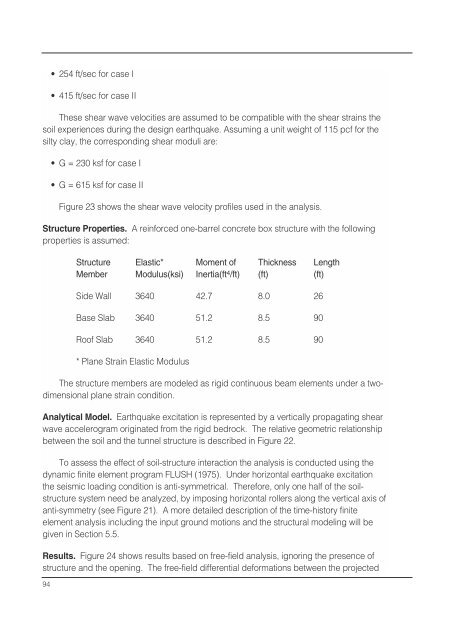Seismic Design of Tunnels - Parsons Brinckerhoff
Seismic Design of Tunnels - Parsons Brinckerhoff
Seismic Design of Tunnels - Parsons Brinckerhoff
Create successful ePaper yourself
Turn your PDF publications into a flip-book with our unique Google optimized e-Paper software.
• 254 ft/sec for case I<br />
• 415 ft/sec for case II<br />
These shear wave velocities are assumed to be compatible with the shear strains the<br />
soil experiences during the design earthquake. Assuming a unit weight <strong>of</strong> 115 pcf for the<br />
silty clay, the corresponding shear moduli are:<br />
• G = 230 ksf for case I<br />
• G = 615 ksf for case II<br />
Figure 23 shows the shear wave velocity pr<strong>of</strong>iles used in the analysis.<br />
Structure Properties. A reinforced one-barrel concrete box structure with the following<br />
properties is assumed:<br />
Structure Elastic* Moment <strong>of</strong> Thickness Length<br />
Member Modulus(ksi) Inertia(ft 4 /ft) (ft) (ft)<br />
Side Wall 3640 42.7 8.0 26<br />
Base Slab 3640 51.2 8.5 90<br />
Ro<strong>of</strong> Slab 3640 51.2 8.5 90<br />
* Plane Strain Elastic Modulus<br />
The structure members are modeled as rigid continuous beam elements under a twodimensional<br />
plane strain condition.<br />
Analytical Model. Earthquake excitation is represented by a vertically propagating shear<br />
wave accelerogram originated from the rigid bedrock. The relative geometric relationship<br />
between the soil and the tunnel structure is described in Figure 22.<br />
To assess the effect <strong>of</strong> soil-structure interaction the analysis is conducted using the<br />
dynamic finite element program FLUSH (1975). Under horizontal earthquake excitation<br />
the seismic loading condition is anti-symmetrical. Therefore, only one half <strong>of</strong> the soilstructure<br />
system need be analyzed, by imposing horizontal rollers along the vertical axis <strong>of</strong><br />
anti-symmetry (see Figure 21). A more detailed description <strong>of</strong> the time-history finite<br />
element analysis including the input ground motions and the structural modeling will be<br />
given in Section 5.5.<br />
Results. Figure 24 shows results based on free-field analysis, ignoring the presence <strong>of</strong><br />
structure and the opening. The free-field differential deformations between the projected<br />
94
















